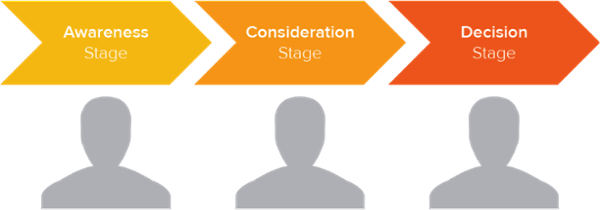To have a successful inbound marketing strategy you have to understand the buyer's journey and map your content so it naturally leads your ideal customer from being a visitor and into a customer. It might sound complex, but it's not. Here's how to map content to your buyer's journey.

1) Create your buyer persona
If you haven't already, then this is an important step. Before you can map content to your buyer's journey, you have to understand your ideal persona.
Your buyer persona profile will highlight what your ideal customer's pain points, ambitions and more actually are. This information will help you make a content plan that engages with your ideal buyer at any stage of the journey.
If you still need to create your buyer persona, we've got a free template you can use to get started. Here you go...
2) Consider what your ideal persona is looking for in each stage of the buyer's journey
Looking at the three stages of the journey, you need to consider what questions your ideal persona will have in each stage.
Remember...
Awareness: The buyer is aware they have a problem but not sure how to fix it yet.
Consideration: The buyer understands what their problem is and they are researching for the best solution.
Decision: They know what they want, they are looking for the best product or the best seller to buy the product/service from.
By looking at your ideal persona and the buyer's journey you can assess what type of topics will fit where and what will link your map together.
3) Map the buyer's journey
I'll use an example to help you map your own content.
Here is Business Beth, she is the ideal persona for Imagine Punctuality Ltd. who has created an online project management tool.

Age: 35
Job: Manager
Bio: Business Beth is a successful team leader at an advertising company. She likes to wake up early, get ready for work and then take her kids to school. While on the train to work, she spends her time reading articles online about improving team work and morale in the office. When she arrives at work, she catches up with her team and then dives into her workload. She has an assistant who does any research she requires but Beth likes to do some of her own as well. The main problem she has at work is making sure her team meet their monthly deadlines. There are lots of tasks and it's not always clear which colleague is working on which project. Because of confusion, she has to have more meetings than she needs to and this takes valuable time away from her other responsibilities.
Beth's buyer's journey
In the case of Business Beth, her journey could look like this:
Awareness: I have a problem, my team isn't meeting their deadlines.
Consideration: I need to find a solution that will benefit my team so they stick to their deadlines and I can stay informed of what's going on, without having 2-3 meetings a week.
Decision: I have to buy a project management system but I need to find one that meets my needs and is affordable.
Mapping content to Beth's Journey
For your own buyer persona, look at their pain points and what journey they would make.
Understanding what they are looking for at each stage will help you decide the topics you will cover and how it will map together.
Here are some example blogs Business Beth may be interested in reading:
Awareness: 10 Reasons Your Project Is Falling Behind Schedule
Consideration: 6 Ways You Can Improve Your Team's Time Management
Decision: How Imaginary Punctuality's Project Management Tool Will Save You Time
The nature of these blog titles are designed to answer Business Beth's needs and move her along the journey. You can see how she started with a problem and then by the time she's reached the decision stage, she's almost a customer.
The purpose of your content is to answer their needs AND then move them (or at least give them the opportunity to move) to the next stage of the buyer's journey.
While the layout of the journey stays the same, potential customers can travel along it in different ways. Some customers may come into the journey in the consideration stage and miss awareness entirely.
What type of content can I use for each stage of the buyer's journey?
You have quite a lot of freedom when it comes to choosing the content format you want to use to interact with your ideal buyer.
But the most important thing to remember is that the content has to be helpful and engage with the needs of your ideal customer depending on what stage of the journey they're in.
Here are some examples to help you get started:
| Awareness | Consideration | Decision |
|
Blogs eBooks Educational content Research reports Fact Guides |
Blogs eBooks & Guides Specialist Content Webinar/Podcast Video White Paper |
Blogs eBooks & Guides Testimonials Case Studies Seller/Product Comparison Video |
Be smart with your marketing, use these techniques for your business
To get the best results with your marketing, you need to be smart with the techniques you're using. Our team at Digital 22 have shared insider tips on how to improve your inbound marketing strategy. Check out our free eBook:
Real Growth. Real Impact.
'Should I use HubSpot?' 32 fundamental reasons why you should
21 cost-effective marketing campaigns you can create right now
Breeze: Everything you need to know about HubSpot's powerful AI
INBOUND 24 learnings and updates
Google Search API leaks: All you need to know [LIVE BLOG]
The top 6 marketing challenges of 2024
Inbound vs outbound marketing: What's the difference?
See why enterprises choose Avidly
Let’s build your HubSpot success story
Compelling final call to action - with accompanying link to Contact page





![Google Search API leaks: All you need to know [LIVE BLOG]](https://www.avidlyagency.com/hs-fs/hubfs/cloud.jpg?width=400&height=225&name=cloud.jpg)


